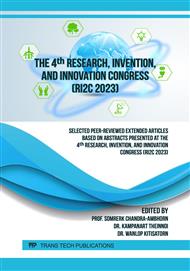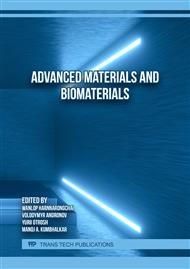[1]
P. Edward. Furlani, Magnetic Biotransport: Analysis and Applications, Materials. 3 (2010) 2412-2446.
Google Scholar
[2]
S.S.R. Challa Kumar, and F. Mohammad, Magnetic nanomaterials for hyperthermia-based therapy and controlled drug delivery, Adv. Drug Delivery Revi. 63 (2011) 789-808.
DOI: 10.1016/j.addr.2011.03.008
Google Scholar
[3]
P.B. Shete R.M. Patil N.D. Thorat A. Prasad R.S, Ningthoujam S.J. and Ghosh S.H. Pawar, Magnetic chitosan nanocomposite for hyperthermia therapy application: Preparation, characterization and in vitro experiments, Appl. Surf. Sci. 288 (2014) 149-157.
DOI: 10.1016/j.apsusc.2013.09.169
Google Scholar
[4]
I.P. Paula, S.D. Machado, C.L. Laura´, C.J. Pereira Joana T. Coutinho Isabel, M.M. Ferreira Carlos, M.M. Novo, J. P. Borges, Thermal and magnetic properties of chitosan-iron oxide nanoparticles, Carb. Poly. 149 (2016) 382-390.
DOI: 10.1016/j.carbpol.2016.04.123
Google Scholar
[5]
S.S. Abdelnasser Ibrahim, A.A. A-Salamah, A.M. E-Toni, M.A. El-Tayeb, Y.B. Elbadawi, Immobilization of cyclodextrin glucanotransferase on aminopropylfunctionalized silica-coated superparamagnetic nanoparticles, Elec. J. Bio. 0717-3458 (2013) 001–017.
DOI: 10.2225/vol16-issue6-fulltext-8
Google Scholar
[6]
S.L. Gawali, S.B. Shelar, J. Gupta, K.C. Barick, P.A. Hassan, Immobilization of protein on Fe3O4 nanoparticles for magnetic hyperthermia application, I. J. Bio.M.166 (2021) 851–860.
DOI: 10.1016/j.ijbiomac.2020.10.241
Google Scholar
[7]
K.D. Kim, S.S. Kim, Y.H. Choa, H. T. Kim, Formation and Surface Modification of Fe3O4 Nanoparticles by Co-precipitation and Sol-gel Method, J. Ind. Eng. Chem. 13.7 (2007) 1137-1141.
Google Scholar
[8]
T. Marin, P. Montoya, O. Arnache, J.A. Calderon, Influence of Surface Treatment on Magnetic Properties of Fe3O4 Nanoparticles Synthesized by Electrochemical Method, J. Phys. Chem. B. (2016) 001-051.
Google Scholar
[9]
N. Rajkumar, D. Umamahaeswari, K. Ramachandran, Photoacoustics and magnetic studies of Fe3O4 nanoparticles, Inter. J. Nanosci. 9.3(2010) 243–250.
DOI: 10.1142/s0219581x10006685
Google Scholar
[10]
F.C Rodrigo Marques, C. cile Garcia, P. Lecante, J.L Sidney Ribeiro, L. Noe´, J.O. Nuno Silva, V.S. Amaral, A. Milla´n, M. Verelst, Electro-precipitation of Fe3O4 nanoparticles in ethanol, J. of Magnet. and Mag. Materials, 320 (2008) 2311– 2315.
DOI: 10.1016/j.jmmm.2008.04.165
Google Scholar
[11]
A.P.A. Faiyas, E.M. Vinod, J. Joseph, R. Ganesan, R.K. Pandey, Dependence of pH and surfactant effect in the synthesis of magnetite (Fe3O4) nanoparticles and its properties, J. of Magnet and Mag Materials, 322 (2010) 400–404.
DOI: 10.1016/j.jmmm.2009.09.064
Google Scholar
[12]
Y. Liu, P. Liu, Z. Su, F. Li, F. Wen, Attapulgite - Fe3O4 magnetic nanoparticles via co-precipitation technique. Appl. Surf. Sci. 255 (2008) 2020–2025.
DOI: 10.1016/j.apsusc.2008.06.193
Google Scholar
[13]
N.D. Kandpal, N. Sah, R. Loshali, R. Joshi, J. Prasad, Co-precipitation method of synthesis and characterization of iron oxide nanoparticles, J. of Scient. and Indust. Resear. 73 (2014) 87-90.
Google Scholar
[14]
M. Li, X. Sui, Synthesis and characterization of magnetite particles by co-precipitation method, Key Engineering Materials, 512-515 (2012) 82-85.
DOI: 10.4028/www.scientific.net/kem.512-515.82
Google Scholar
[15]
F. Wang, C. Yin, X. Wei, Q. Wang, L. Cui, Y. Wang, T. Li, J. Li, Synthesis and characterization of superparamagnetic Fe3O4 nanoparticles modified with oleic acid, Integrat. Ferroelec. 153 (2014) 92–101.
DOI: 10.1080/10584587.2014.903062
Google Scholar
[16]
P. Tipsawat, U. Wongpratat, S. Phumying, N. Chanlek, K. Chokprasombat, S. Maensiri, Magnetite (Fe3O4) nanoparticles: Synthesis, characterization and electrochemical properties, Appl. Surf. Sci. 446 (2018) 287-292.
DOI: 10.1016/j.apsusc.2017.11.053
Google Scholar
[17]
Y. Li, H. Liao, Y. Qian, Hydrothermal synthesis of ultrafine α–Fe2O3 and Fe3O4 powders, Mater. Resear. Bulletin, 33 .6 (1998) 841-844.
DOI: 10.1016/s0025-5408(98)00055-5
Google Scholar
[18]
S. Wu, A. Sun, F. Zhai, J. Wang, W. Xu, Q. Zhang, A.A. Volinsky, Fe3O4 magnetic nanoparticles synthesis from tailings by ultrasonic chemical co-precipitation, Mater. Lett. 65. 12 (2011) 1882-1884.
DOI: 10.1016/j.matlet.2011.03.065
Google Scholar
[19]
I. Safarik and M. Safarikova, Magnetic techniques for the isolation and purification of proteins and peptides, Biomagn. Res. Technol.2(7) (2004)
DOI: 10.1186/1477-044X-2-7
Google Scholar
[20]
M. Gao, C. Deng and X. Zhank, Magnetic nanoparticles based digestion and enrichment methods in proteomics analysis, Expert. Rev. Proteomics 8(3) (2011) 379-390.
DOI: 10.1586/epr.11.25
Google Scholar
[21]
M.Z. Borowska, Magnetic nanoparticles coated with aminated starch for HSA immobilization- simple and fast polymer surface functionalization, Inter. J. Bio. Macro. 136 (2019)106-114.
DOI: 10.1016/j.ijbiomac.2019.06.044
Google Scholar
[22]
X. Yang, X. Zhang, Y. Ma, Y. Huang, Y. Wanga and Y. Chen, Superparamagnetic graphene oxide–Fe3O4 nanoparticles hybrid for controlled targeted drug carriers, J Materials Chemistry (2009) 2710-2714.
DOI: 10.1039/b821416f
Google Scholar
[23]
F. Liu, F. Niu, N. Peng,ab Y. Su and Y. Yang, Synthesis, characterization, and application of Fe3O4@SiO2-NH2 nanoparticles, J RSC Advances 5(2015), 18128-18136.
DOI: 10.1039/c4ra15968c
Google Scholar



